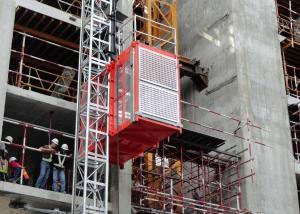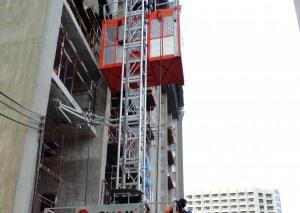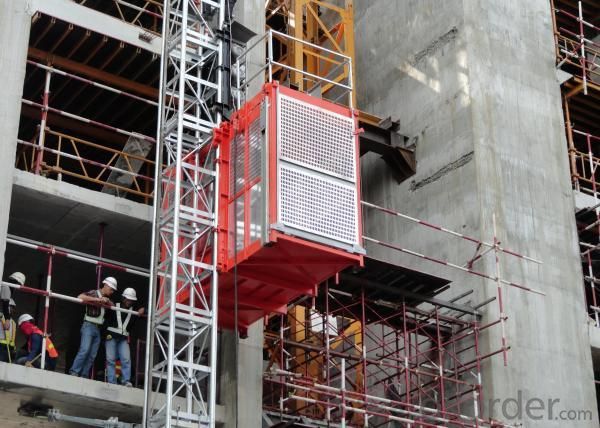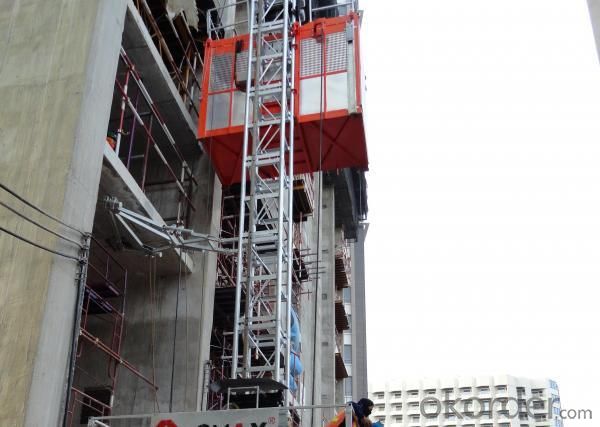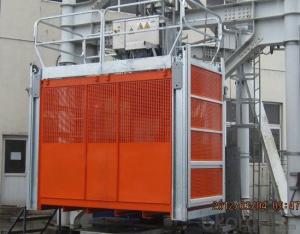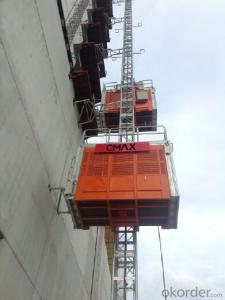Building Hoist SC100
- Loading Port:
- China Main Port
- Payment Terms:
- TT or L/C
- Min Order Qty:
- 1 Set set
- Supply Capability:
- 90 Sets Per Month set/month
OKorder Service Pledge
OKorder Financial Service
You Might Also Like
Building Hoist SC100 Technical Data
|
Lifting capacity |
1000kg |
|
Lifting speed |
33 m/min, 38m/min, 0-60m/min (VVVF+PLC), 0-90m/min (VVVF+PLC) |
|
Max. lifting height |
300m |
|
Motor type |
Chinese motor or SEW motor |
|
Anti-drop safety device |
With our patent |
|
Cage size (L x W x H) |
Recommended size: 2.5x1.2x2.4m. We can also manufacture the cages of other sizes according to the clients. |
|
Mast section |
450x450x1508mm, hot dip galvanized or paint-sprayed. |
|
Anchor |
Distance 6-9m, hot dip galvanized or paint-sprayed. |
|
★Thewhole machinecan be designed according to your specific requirements | |
Details of Hoist SC100 Technical Data
SC100 building hoist manufactured by our company have the features as good quality, long life, wide application range and convenient for maintenance. The gearing adopts imported bearing, enameled cable, and oil seal.
The electric parts adopt products from world renowned manufactures such as Schneider, Siemens, and LG.
The racks amd pinion adopts special material and heat-treatment technique, which prolong the life of these parts.
The steel structure uses quality steel from famous domestic manufacturers. The surface of the structure can apply paint-spray, parkerizng baking finish or hot galvanizing processing according to users requirements.
We can also manufacture cages of other size according to the user
The cage and the door material can be aluminum molded board, punched-plate,figured aluminum board or other type according to your requirementes
The mas and the tie-in surface can adopt paint-spray, or hot galvanizing processing.
We has passed ISO9000 quality system authentication. We have powerful R&D centre and professional customer support team. Excellent quality and service are what we actually supply with.
Packaging & Delivery
Package: nude and wooden boxes in containers.
Period of shipment: 30 days after receipt of the buyer's advance payment.
.
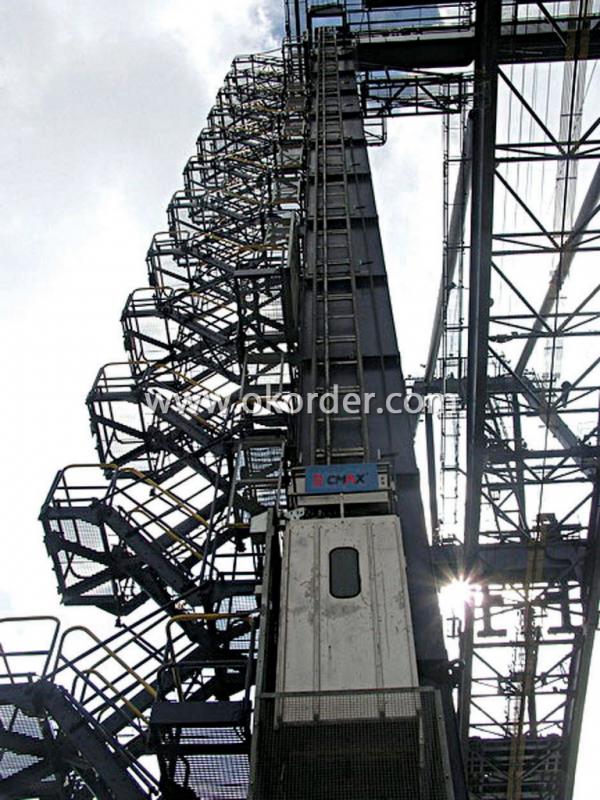
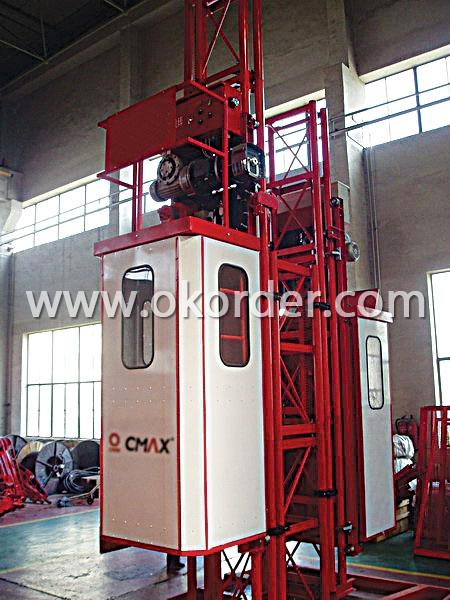
- Q: Is it possible to utilize a building hoist for the purpose of lifting small tools and equipment?
- <p>Yes, a building hoist can be used for lifting small tools and equipment, provided it is within the hoist's weight capacity. It's important to ensure that the items are securely fastened to prevent any accidents during lifting. Always follow the manufacturer's guidelines and safety regulations when using a building hoist for any lifting tasks.</p>
- Q: This question asks for a comparison between electric and manual lifting equipment, highlighting their distinct features and operational differences.
- <p>Electric lifting equipment, such as electric hoists and cranes, operates using electrical power and is designed for heavy-duty lifting and repetitive tasks. It offers high efficiency, ease of use, and often requires less physical effort from operators. On the other hand, manual lifting equipment, like levers, pulleys, and manual hoists, relies on human power and is typically used for lighter loads or in situations where electrical power is not available. Manual equipment is generally more portable and requires no power source, but it is slower and more labor-intensive. Electric equipment is more suitable for industrial settings, while manual equipment is often used in smaller-scale operations or for temporary tasks.</p>
- Q: This question asks about the steps or measures to ensure the safe installation of a building hoist, which is a device used in construction for lifting materials and personnel.
- <p>To install a building hoist safely, follow these steps: 1. Ensure the site is clear and secure, with proper access and no obstructions. 2. Check that the hoist is suitable for the load and building structure. 3. Assemble the hoist according to the manufacturer's instructions. 4. Install the hoist on a stable and level base, ensuring it is securely anchored to the building. 5. Conduct a thorough inspection of all components for any defects or damage. 6. Test the hoist with a trial run to ensure all functions work correctly. 7. Train operators on the safe use and operation of the hoist. 8. Obtain any necessary permits and inspections from local authorities. 9. Regularly inspect and maintain the hoist to ensure ongoing safety.</p>
- Q: The user is asking if it's possible to substitute a hydraulic lifting device for a building hoist in construction.
- <p>Yes, a hydraulic lifting device can be used as an alternative to a building hoist in certain scenarios. Hydraulic devices offer precise control and smooth operation, which can be advantageous for lifting heavy construction materials. However, it's important to consider the specific requirements of your project, such as the weight and size of the materials to be lifted, the height of the lift, and the frequency of use. Hydraulic systems are generally more expensive and require more maintenance than building hoists, but they can provide greater lifting capacity and versatility. Always ensure that any lifting device used complies with safety standards and regulations.</p>
- Q: What are the alternative uses of a building hoist besides construction?
- <p>Yes, building hoists can be used for other purposes beyond construction. They can be utilized in various industries for material handling, such as in warehouses for moving goods, in factories for lifting machinery, and in maintenance for accessing high areas. Additionally, building hoists can be employed in emergency services for rescue operations, especially in high-rise buildings. They are also used in special events for setting up stages and equipment. The versatility of building hoists makes them a valuable tool in many different scenarios where vertical transportation of materials or personnel is required.</p>
- Q: How long does the construction elevator do a crash test
- You don't have to do it now. Go straight to the test center. A site is tested once
- Q: This question asks for the safety precautions that should be taken when operating electric-hydraulic construction hoists.
- <p>Safety measures for using electric-hydraulic building hoists include regular maintenance and inspection to ensure all components are in good working order. Operators must be trained and certified, following all safety protocols. Never exceed the hoist's load capacity. Ensure that safety hooks and chains are in place and secure. Keep the hoist area clear of debris and unauthorized personnel. Use proper lifting techniques and avoid sudden starts or stops. Always inspect the load before lifting to ensure it is stable and secure. Emergency stop switches should be easily accessible. Ensure that all safety guards are in place and functioning properly. Adhere to all local regulations and manufacturer's guidelines.</p>
- Q: This question asks if a building hoist is capable of lifting objects that vary in size and weight.
- <p>Yes, a building hoist can be used to lift objects of different sizes and weights, but it is crucial to ensure that the hoist's capacity is suitable for the load. Building hoists are designed to handle various materials and equipment during construction, and their lifting capacity can range from a few hundred pounds to several tons. It is essential to check the hoist's specifications and adhere to the maximum load limit to ensure safety and prevent damage to the hoist or the objects being lifted. Always follow the manufacturer's guidelines and safety standards when operating a building hoist.</p>
- Q: The construction of more than many floors must be used for construction elevators
- The construction elevator, the average layer height above 12 floors need to be used, the hoist machine is not to go up to use the construction elevator to send a person to carry a few light things upstairs. Pre-installation preparation: After construction, the manufacturer will show the product certificate and provide the instruction manual. According to the technical requirement of installation safety technology checking list according to the construction elevator, the preparation should be inspected. The installation operator should hold the certificate, accept the technical, safety, etc., and make the safety operation rules for the construction lifter. 3, work environment: 1) the power supply must meet the requirement of power supply. 2) no electricity, gas welding or other obstacles to the operation of the crane are prohibited within the part of the elevator installations. 3) the platforms and channels that enter the building from the suspended cage shall reach the bearing capacity of more than two tons, and have strong protective barriers and protective doors. 4) it is forbidden to use guide rack, attached part scaffold, construction platform and the floor channel stretch, pipeline, rope, rope, banners, flags and other things has nothing to do with the elevator; In the evening homework, there should be sufficient illumination. 6) the doors to the floor will be kept in the door, each with a clear sign of the floor number.
- Q: Is it possible to utilize a building hoist for the transportation of heavy objects?
- <p>Yes, a building hoist is specifically designed to move heavy objects within a construction site or in similar environments. It is a type of crane that can lift and lower materials vertically, making it ideal for transporting heavy items such as construction materials, machinery, and equipment. Building hoists are engineered to handle significant weight loads and are an essential tool for efficient material movement in vertical construction projects.</p>
Send your message to us
Building Hoist SC100
- Loading Port:
- China Main Port
- Payment Terms:
- TT or L/C
- Min Order Qty:
- 1 Set set
- Supply Capability:
- 90 Sets Per Month set/month
OKorder Service Pledge
OKorder Financial Service
Similar products
Hot products
Hot Searches
Related keywords
